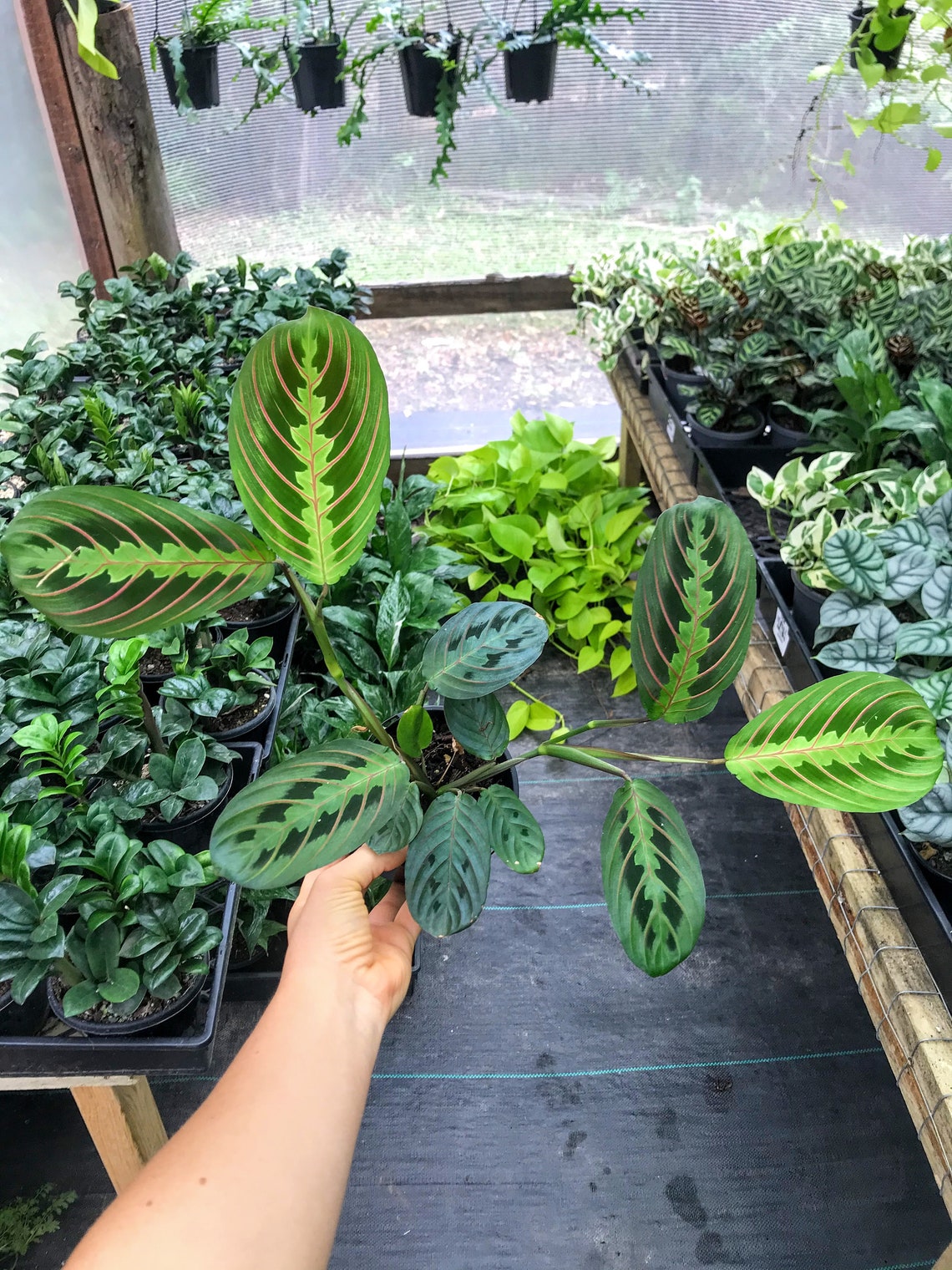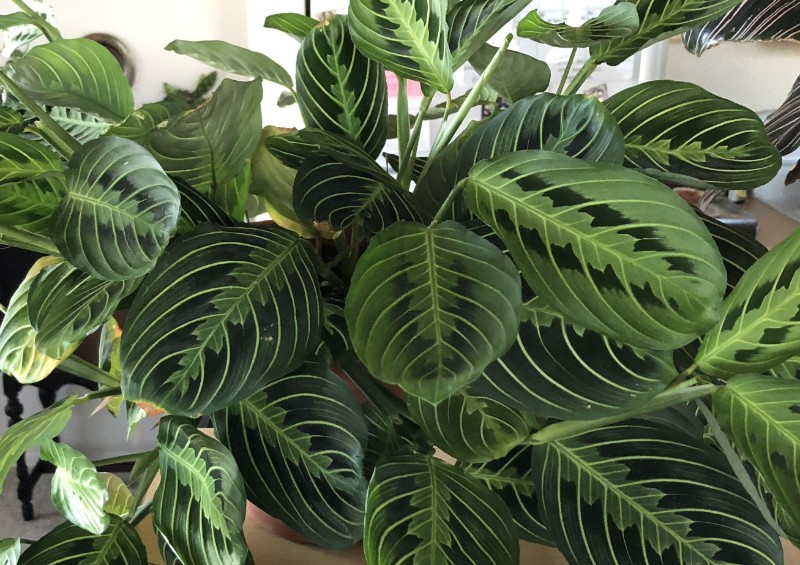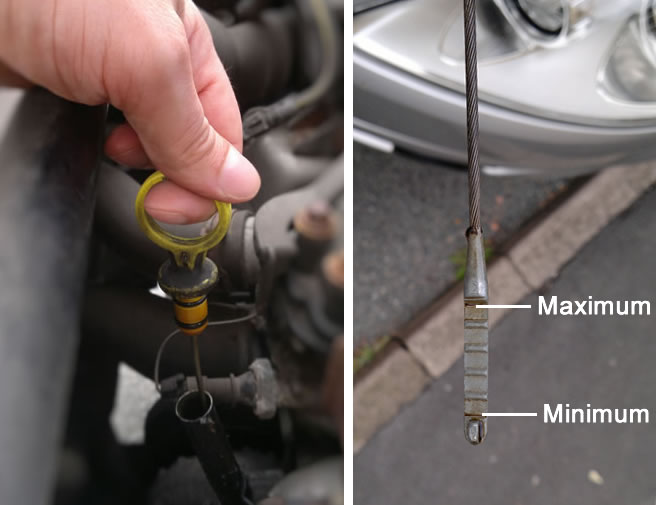Your How to take care of a prayer plant images are ready. How to take care of a prayer plant are a topic that is being searched for and liked by netizens now. You can Download the How to take care of a prayer plant files here. Find and Download all free photos.
If you’re searching for how to take care of a prayer plant images information connected with to the how to take care of a prayer plant interest, you have come to the ideal site. Our site frequently gives you hints for downloading the highest quality video and image content, please kindly hunt and locate more informative video articles and images that fit your interests.
How To Take Care Of A Prayer Plant. Grow a prayer plant in a planting medium composed of two parts peat moss, one part loam and one part sand. Although the prayer plant houseplant is somewhat tolerant of low light conditions, it does best in bright, indirect sunlight. Just remember that it thrives on high humidity and it prefers brighter, indirect sun. How to care for a maranta leuconora (prayer plant) the maranta leuconora, also known as the prayer plant, is a tropical plant that�s closely related to a calathea.
 Taking Care of and Growing the Maranta/Prayer Plant From gardeningleave.org
Taking Care of and Growing the Maranta/Prayer Plant From gardeningleave.org
How do you take care of a prayer plant? Maranta leuconeura care requires an airly potting mix consisting of peat moss, sand, perlite, and a soil ph value of 5.5 to 6. If you know how to take care of a prayer plant, it won’t be an overly demanding species to keep in your home. Hereof, how do you take care of a prayer plant? Maranta species are tropical and live in understory areas of the forest. The leaves are said to have healing properties when placed on the forehead or temples.
Water about once a week and keep the soil slightly moist.
Caring for an indoor prayer plant isn�t difficult. To propagate the prayer plant in water, simply take a clean pair of scissors and cut off a piece below a node. Even with the best care, prayer plants often develop brown tips or leaf edges, and older leaves will fade and die. Prayer plant houseplants should be kept moist, but not soggy. Although the prayer plant houseplant is somewhat tolerant of low light conditions, it does best in bright, indirect sunlight. To restore your plant correctly, prepare a good and nutritious dish for it.
 Source: pinterest.com
Source: pinterest.com
Prayer plant houseplants should be kept moist, but not soggy. Caring for an indoor prayer plant isn�t difficult. Prayer plant houseplants should be kept moist, but not soggy. Plants that are kept too cool or too dry are likely to lose their leaves or suffer from fungal infections that can cause the plant to die from root rot or collapse. Even with the best care, prayer plants often develop brown tips or leaf edges, and older leaves will fade and die.
 Source: smartgardenguide.com
Source: smartgardenguide.com
Your plant will not grow from that point in the future. The vendors can tell you the fertilizer that is most efficient for your plant. Water about once a week and keep the soil slightly moist. Are prayer plants easy to grow? Prayer plant houseplants should be kept moist, but not soggy.
 Source: etsy.com
Source: etsy.com
How to care for a maranta leuconora (prayer plant) the maranta leuconora, also known as the prayer plant, is a tropical plant that�s closely related to a calathea. Prayer plant houseplants should be kept moist, but not soggy. Plants that are kept too cool or too dry are likely to lose their leaves or suffer from fungal infections that can cause the plant to die from root rot or collapse. Hang or set your prayer plant near a window where it will receive indirect sunlight. How do you take care of a prayer plant?
 Source: br.pinterest.com
Source: br.pinterest.com
Lemon lime prayer plants love their acidic nutrients. Maranta species are tropical and live in understory areas of the forest. If you know how to take care of a prayer plant, it won’t be an overly demanding species to keep in your home. Let them run their course as much as you can stand it. The ideal spot for a prayer plant will receive medium to bright indirect light.
 Source: pinterest.com.au
Source: pinterest.com.au
Just remember that it thrives on high humidity and it prefers brighter, indirect sun. The leaves are said to have healing properties when placed on the forehead or temples. They need moist soil and dappled light to shade. How to care for a prayer plant: Droopy prayer plants are often caused by a combination of low humidity, too dry or too wet soil, or too much sunlight.
 Source: proplants.com
Source: proplants.com
Prayer plant houseplants should be kept moist, but not soggy. Do this at half the recommended amount for every two weeks during the spring and summer. Hang or set your prayer plant near a window where it will receive indirect sunlight. Prayer plant houseplants should be kept moist, but not soggy. To restore your plant correctly, prepare a good and nutritious dish for it.
 Source: pinterest.com
Source: pinterest.com
Use a sterilized pair of sharp scissors and clip the stems right above a leaf node. Prayer plant houseplants should be kept moist, but not soggy. This is unique to the prayer plant and can be done sparingly. How to grow a prayer plant. The prayer plant is a very popular houseplant.
 Source: pinterest.com
Source: pinterest.com
Even with the best care, prayer plants often develop brown tips or leaf edges, and older leaves will fade and die. Prayer plant houseplants should be kept moist, but not soggy. Plants that are kept too cool or too dry are likely to lose their leaves or suffer from fungal infections that can cause the plant to die from root rot or collapse. Prayer plant houseplants should be kept moist, but not soggy. Since prayer plants come from the humid environment of the rainforest, they do well with high humidity.
 Source: gravesfloral.com
Source: gravesfloral.com
Fertilize every 2 weeks during the growing season and prune up to three times per year as desired. You can also set a humidifier next to the plant to create extra humidity. Check out a garden store and ask for a suitable nutrient. Your plant will not grow from that point in the future. Fertilize every 2 weeks during the growing season and prune up to three times per year as desired.
 Source: thespruce.com
Source: thespruce.com
How do you take care of a prayer plant? How do you take care of a prayer plant? It’s important for the node to be included on the cutting because that’s where new roots will sprout from. You can also set a humidifier next to the plant to create extra humidity. Droopy prayer plants are often caused by a combination of low humidity, too dry or too wet soil, or too much sunlight.
 Source: pinterest.co.uk
Source: pinterest.co.uk
You can prune your prayer plant to encourage fuller, more vigorous growth. The prayer plant is a very popular houseplant. Use warm water and feed prayer plant houseplants every two weeks,. Hang or set your prayer plant near a window where it will receive indirect sunlight. Hang or set your prayer plant near a window where it will receive indirect sunlight.
 Source: planterina.com
Source: planterina.com
Prayer plant houseplants should be kept moist, but not soggy. Prayer plant houseplants should be kept moist, but not soggy. How do you take care of a prayer plant? You can also set a humidifier next to the plant to create extra humidity. Check out a garden store and ask for a suitable nutrient.
 Source: gardenguides.com
Source: gardenguides.com
Never set your plant in direct sunlight because the sun will scorch the plant’s leaves or the leaves will develop blotches or patches and fade in color intensity. To propagate the prayer plant in water, simply take a clean pair of scissors and cut off a piece below a node. The combination ensures good drainage. Prayer plant houseplants should be kept moist, but not soggy. In this plant care guide, we�re going to look at how you can best take care of this beautiful, yet easy to care for houseplant.
 Source: smartgardenguide.com
Source: smartgardenguide.com
You can prune your prayer plant to encourage fuller, more vigorous growth. How do i make my prayer plant bushy? If you know how to take care of a prayer plant, it won’t be an overly demanding species to keep in your home. You can prune your prayer plant to encourage fuller, more vigorous growth. Droopy prayer plants are often caused by a combination of low humidity, too dry or too wet soil, or too much sunlight.
 Source: sproutsandstems.com
Source: sproutsandstems.com
Prayer plant houseplants should be kept moist, but not soggy. The prayer plant is a very popular houseplant. Fertilize every 2 weeks during the growing season and prune up to three times per year as desired. It’s important for the node to be included on the cutting because that’s where new roots will sprout from. Prayer plant houseplants should be kept moist, but not soggy.
 Source: pinterest.com
Source: pinterest.com
Maranta species are tropical and live in understory areas of the forest. How to care for a prayer plant: When trimming brown or yellow foliage, use a clean, sterilized pair of scissors or pruners. How to grow a prayer plant. How do you take care of a prayer plant?
 Source: youtube.com
Source: youtube.com
Just remember that it thrives on high humidity and it prefers brighter, indirect sun. How do you cut dead leaves off a prayer plant? Surprisingly, your prayer plant will also enjoy your leftover tea. The plant will grow new shoots directly below the cut area making for a bushier appearance. Droopy prayer plants are often caused by a combination of low humidity, too dry or too wet soil, or too much sunlight.
 Source: indoorplantcenter.com
Source: indoorplantcenter.com
How do you cut dead leaves off a prayer plant? Low humidity can make the prayer plant susceptible to yellow leaves, leaf loss, and fungal infections. Just remember that it thrives on high humidity and it prefers brighter, indirect sun. The combination ensures good drainage. How to care for a prayer plant:
This site is an open community for users to submit their favorite wallpapers on the internet, all images or pictures in this website are for personal wallpaper use only, it is stricly prohibited to use this wallpaper for commercial purposes, if you are the author and find this image is shared without your permission, please kindly raise a DMCA report to Us.
If you find this site adventageous, please support us by sharing this posts to your preference social media accounts like Facebook, Instagram and so on or you can also save this blog page with the title how to take care of a prayer plant by using Ctrl + D for devices a laptop with a Windows operating system or Command + D for laptops with an Apple operating system. If you use a smartphone, you can also use the drawer menu of the browser you are using. Whether it’s a Windows, Mac, iOS or Android operating system, you will still be able to bookmark this website.





